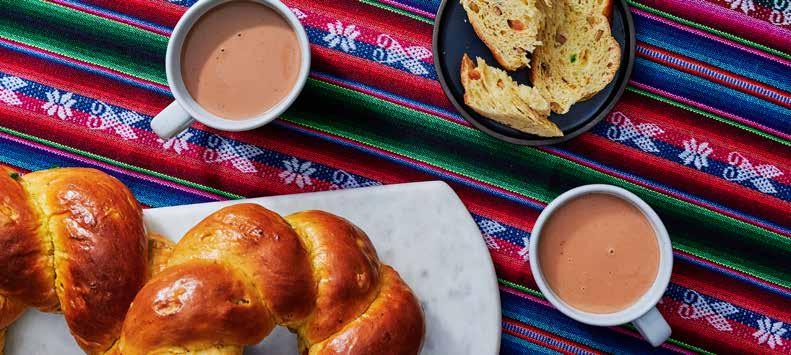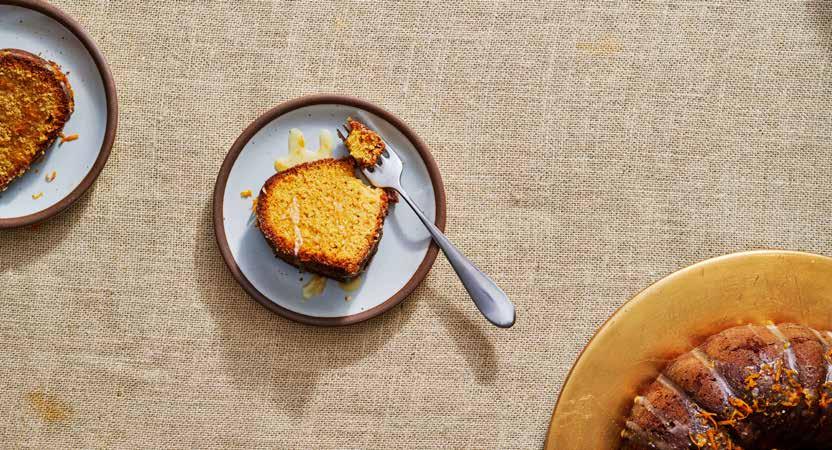
7 minute read
FOODWAYS
FROM OUR GRANDMOTHERS’ HANDS
At 7 years old, I walked into my grandmother’s kitchen, high on a ridge in the Driftless region, just outside Richland Center. I scooted right in, kneeling on a chair alongside older cousins; the aroma of fried, sweet dough in the air. Her kitchen was my favorite place, with big windows looking over the land, a dining table that could accommodate a crowd, and a fieldstone fireplace with a small kitchen witch poppet hanging at the mantle, evoking our northern European heritage. The tag around the witch’s neck shared a message that the power to keep roasts from burning, pots from boiling over, and plates from dropping was somehow out of worldly control and in the magical protection she provided this place. Grandma was working over a bubbling pot, making rosettes for the holidays: airy, light fried cookies in the shape of snowflakes that are served with a dusting of sugar. Impossibly simple in theory, but technical in execution!
Advertisement
I hopped in to take part in this master class as she was teaching us how to tell when the oil was just right—using a thermometer, but also knowing what to look for. “Too hot and the batter will burn on the edges before it cooks through, too cool and you will have oil-soaked cookies.” I learned how to heat the rosette irons and keep them clean, how to release the dough, and how to sift the sugar gently, leaving some of the golden cookie peeking through. We gobbled up the ones that didn’t turn out quite right.
This sharing and passing down of holiday food tradition, with all the details that are rarely shared on the recipe card is the real charm—the sense memory and the connection to the people of our past. Taking time to practice these traditions in our kitchens now and adjust them to the pace and space of our modern lives helps tether us to our family history and identity. It gives us space to be present with those memories and make new ones, with a sweet reward.
I love asking friends about their own favorite food traditions and watch for that far-off look, that sparkle in the eye, that comes with the delight of recalling a delicious bite or a precious time. Here, we gather together a few of these recipes and stories, providing inspiration for you in your festive kitchens, to share or reclaim your traditions and explore something new, inspired by the magic of our grandmother’s hands.
GRANDMA ELLIOTT’S ROSETTES
Serves 36 rosette cookies Prep time: 15 minutes Cook time: 40 minutes to 1 hour, depending on the number of irons
INGREDIENTS
2 eggs 1 tablespoon sugar 1/4 teaspoon salt 1 cup all-purpose flour, sifted 1 cup whole milk 1 teaspoon vanilla Oil for frying (Grandma always used vegetable oil) 1 cup confectioners’ sugar OR 1 cup granulated sugar whisked with 2 teaspoons cinnamon
DIRECTIONS
1. Beat the eggs with 1 tablespoon sugar and 1/4 teaspoon salt. 2. Whisk half the flour into the egg mixture, then half the milk, blending until smooth.
Repeat with the remaining flour and milk; stir in the vanilla. 3. The batter should be very smooth and the consistency of a thin pancake batter, the batter should coat the back of a spoon well, but drip off. If it is too thick, add a teaspoon of milk at a time. The consistency of the batter is critical. If you have any lumps, strain them out. 4. Heat 3 inches of oil in a deep, heavy-bottomed pot or in a deep fryer to 365 degrees F. Place the clean and dry rosette iron in the hot oil for 60 seconds. The iron must be hot. 5. Lightly stamp the iron on a clean dry cloth to remove excess oil, then dip the hot iron into the batter, making sure not to let the batter run over the top of the iron. If you do, the rosette will be impossible to remove. 6. Immerse the coated iron in the hot oil; fry for 25-30 seconds until light brown. Use a metal spatula or butter knife to loosen the cookie from the iron and place the cookies on a towel- lined rack to drain and cool. 7. Dust with confectioners’ sugar or cinnamon sugar mixture while still warm.
Find the recipes online at ediblemadison.com/ grandmothershands
FROM CHEF PATIENCE CLARK
My favorite baking tradition is making pound cakes before Thanksgiving and Christmas dinner, a tradition that comes from my 98-year-old greatgrandmother Louise Dunlap. She’s been baking pound cakes since she was a COMMUNITY ACTION COALITIONyoung girl, and her and my Big Momma (grandmother) Melva, have always FIGHTS FOR FOOD SECURITYkept the tradition alive. They both still work together to prepare our family holiday dinners to this day! by Emily McCluhan
I feel like I’m able to connect to my history by preparing and eating things that my ancestors created and/or thrived on. It’s always so hard to pinpoint the exact history of the Black Foodways, but one thing we do know is that pound cake was an easy recipe passed down orally to people who couldn’t read and write. That is where the name comes from, adding one pound of every ingredient. As time went on, portions were adjusted and leaveners were added to lighten the cake. Now, I am a descendent that is furthering the innovation of this truly historic dessert. The tradition still shows up at almost every family gathering. And I like to add a modern spin to the pound cakes by diversifying the flavors. I’ve made strawberry cream pound cake, peach cobbler pound cake, sweet potato pound cake, and many other varieties.
Chocolate caliente prrpared by Cynthia from her mothers recipe. Panettone baked by Cabibbo’s Bakery in Stoughton.

CHRISTMAS PUDDING MEMORIES
FROM RONNIE HESS
Adapted from an article that first appeared in The Milwaukee Journal Sentinel, December 21, 2008. Reprinted with permission.
Beyond my mother’s perfect King’s-standard British English, there was food. Perhaps the most important dish was the plum pudding she steamed for hours at Christmas. She brought it to the table almost black, decorated with a sprig of holly, and flaming gently blue with brandy, the crowning dessert after a dinner of roast goose. She never mentioned how Christmas pudding became part of her family’s tradition. There was no family recipe handed down over generations, no special pudding basin taken down from the shelf and covered with cheesecloth for steaming. And my mother didn’t follow any of the British customs associated with the pudding. She never insisted on each of us stirring the dough clockwise, mimicking the sun’s movements; never stuffed it with a silver coin, also for good luck; and never served it with hard sauce. Rather, she would put out a dish of granulated or confectioners’ sugar in deference, she said, to those who had a sweeter tooth than was probably good for them.
»»»»»»» RECUERDOS DE PANETÓN Y CHOCOLATE CALIENTE

CON CYNTHIA GARCIA Full English translation by Jenina Mella available online at ediblemadison.com. Viviendo aquí en los estados unidos con mi mama y mi hijo, invitamos a los familiares más cercanos si en caso no vamos a nuestro país. Preparamos nuestro puerco al horno con un delicioso arroz arabe preparado por mami, chocolate caliente y su infaltable panetón en la mesa. Creo que no hay Peruano que deje de tener un panetón en la mesa para la cena navideña. Es una tradición que adoptamos en el transcurso de los siglos de los Italianos que ahora es parte de la costumbre en sudamérica.
Lo que sí extraño mucho es cuando mi madre hacía su chocolatada para todos los niños del barrio. Solíamos ir de compras para darle unos pequeños obsequios a cada niño. 23 de Diciembre, despiertos con el olor a chocolate y cortando los panetones y untarlos de mantequilla y escuchar los niños felices sentados en las mesas, esperando por su chocolate caliente y tajada de panetón. Una pequeña fiesta con los payasos haciéndonos divertir y al final proceder con fila para entregar los obsequios a los niños. Eso es gratitud, la que mis padres me enseñaron, retribuyendo de una manera positiva a la comunidad después de todo lo bueno que pudimos obtener durante el año. “THAT IS GRATITUDE, WHAT MY PARENTS TAUGHT ME, TO REWARD THE COMMUNITY IN A POSITIVE WAY AFTER ALL THE GOOD WE WERE ABLE TO ENJOY DURING THE REST OF THE YEAR”.








